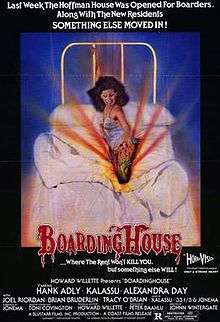Boardinghouse (film)
| Boardinghouse | |
|---|---|
 | |
| Directed by | John Wintergate |
| Produced by | Peter Baahlu |
| Written by | John Wintergate |
| Starring |
John Wintergate
|
| Cinematography |
Jan Lucas
|
Production company |
Blustarr |
| Distributed by | Coast Films |
Release date |
|
Running time |
98 minutes
|
| Country | United States |
| Language | English |
| Budget | US$10,000 |
Boardinghouse (also known as Boarding House and Housegeist) is a 1982 American supernatural horror film written, directed and starring John Wintergate. It was the first horror film to be shot on video.[1]
Plot
On September 18, 1972, the Hoffman house was closed due to several mysterious deaths. Ten years later, the house is reopened as a boarding house by a man with telekinetic powers who inherited it. A group of nubile young women quickly move in and the killings begin all over again.
Cast
- John Wintergate as Jim Royce/Gardner (as Hawk Adly)
- Kalassu as Victoria
- Alexandra Day as Debbie Hoffman
- Joel Riordan as Joel Weintraub
- Brian Bruderlin as Richard
- Selma Kora as Sandy
- Tracy O'Brian as Suzie
- Mary McKinley as Cindy
- Rosane Woods as Gloria
- Cindy Williamson as Pam
- Christopher Conlan as Christopher
- Elizabeth Hall as Terri
- Tom Mones as The Agent
- Dean Dissico as Harris
- Elliot Van Koghbe as Officer Weston
Production
The original idea for the project was developed by John & Kalassu Wintergate at the end of 1978 and the script was started with the idea to film a comedy horror movie. A year or so later Elliot Van Koghbe read an article in American Cinematographer. The article mentioned that George Lucas was experimenting with producing films shot originally on video. Wintergate also had the same idea, because the large funds for a 35 mm production was not yet available. So after researching the idea more closely Wintergate decided to venture into producing a low-budget comedy horror film on video reserving the major portion of the budget for the expense of making the transfer to film. J & K Wintergate funded the project and wrote the script. As an assistant casting director in Hollywood, Van Koghbe had experience with video equipment that was helpful. He, under an alternate name (Obee Ray), also shot a couple of extra sequences for the eventual re-edit which the distributer insisted on. The distributor, in order to make it strictly horror, insisted for most of the real comedy scenes to be cut, which of course ended up to be virtually impossible since everything was shot with the underlying comedy aspect. This made it into a quirky somewhat puzzling film but it inadvertently helped the film to become an eventual cult classic all over the world.
Boardinghouse is notable for being the first horror film to be shot on video.[2][1]
The film also used a movie gimmick titled Horror Vision, wherein a warning would pop up on the screen to let audiences know that a violent scene was happening soon.[3]
Release
Despite being a shot-on-video project, the movie was blown up to 35 mm film and was given a limited release theatrically in the United States by Coast Films, with screenings beginning on October 21, 1983.[lower-alpha 1]
Home media
It was later released on VHS by Paragon Video Productions.[5]
The film was officially released on DVD by Code Red in 2008.[6] The DVD is now out of print.
On February 25, 2013, Slasher // Video founder Jesús Terán announced via a Youtube video that he had obtained the rights to release Boardinghouse for its 30th anniversary. The film was remastered from the original Betacam tape. The special features include a never before seen Director's Cut which is twice the length of the film, featuring several scenes cut from the previously released version due to the distributors request. Other features include a brand new commentary with director John Wintergate and actress/wife Kalassu, two never before seen interviews, two music videos made the same time as Boardinghouse, an extensive group of trailers and television spots, photo gallery, and more. The DVD was released on July 22, 2013 by Slasher // Video, being the first ever DVD to feature a Microsoft Xbox 360 Platinum Hits keep case.
Critical reception
A contemporaneous review published in Cinefantastique noted: "This film is a perfect example of why horror grosses have plummeted at the box-office. Charging anyone to see this crap is a crime. Special effects, acting and production values are non-existent."[7]
In anticipation for a 2017 revival screening, the Chicago Film Society wrote of the film: "Boardinghouse is an essential piece of lunatic cinema, complete with requisite high levels of gore and camp."[8] Noel Murray of The A.V. Club described the film as "a shotgun marriage of Halloween, Carrie and The Amityville Horror."[9] In his book The Gorehound’s Guide to Splatter Films of the 1980s, film scholar Scott Aaron Stine called the film "godawful lousy."[10]
Notes
References
- 1 2 Stine 2003, p. 45.
- ↑ "Boardinghouse (DVD) review". 10kbullet. Retrieved April 17, 2011.
- ↑ "Boardinghouse (DVD) review". Dread Central. Retrieved April 17, 2011.
- ↑ "Theaters and Times". Detroit Free Press. Detroit, Michigan. October 21, 1983 – via Newspapers.com.

- ↑ "Company Credits for Boardinghouse". imdb.com. Retrieved April 17, 2011.
- ↑ "Boardinghouse (DVD)". DVD Empire. Retrieved April 17, 2011.
- ↑ Clarke, Frederick S., ed. (1984). "Boardinghouse". Cinefantastique. F.S. Clarke. 14 (2–5): 109. ISSN 0145-6032.
- ↑ "Experience Boardinghouse in All the Psychedelic Madness of Horror Vision – Music Box Midnights – 35mm Screening". Chicago Film Society. January 12, 2017. Retrieved April 4, 2018.
- ↑ Murray, Noel (October 17, 2008). "Films That Time Forgot: Boardinghouse (1982)". The A.V. Club. Retrieved December 30, 2017.
- ↑ Stine 2003, p. 54.
Works cited
- Stine, Scott Aaron (2003). The Gorehound’s Guide to Splatter Films of the 1980s. McFarland. ISBN 978-1-476-61132-7.